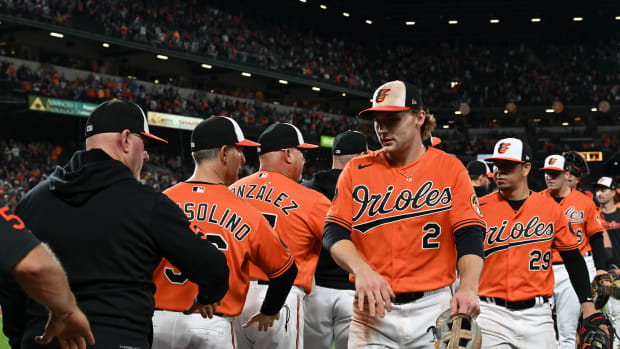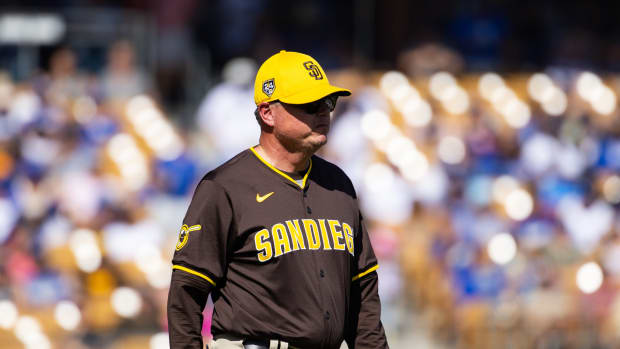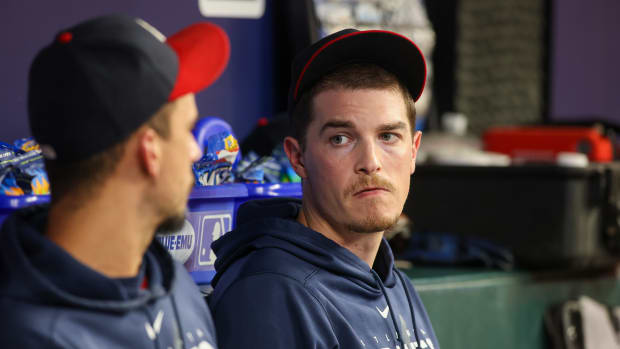Why Star Red Sox Rookies Rafael Devers and Andrew Benintendi Value Contact Over Power
The Cherubic Kid, known as Large Child or Baby Face as he zoomed through the Red Sox' minor league system, stepped out of the box in astonishment, as if inching back after the first glimpse down from the edge of a high dive. He tilted his head. So this is what that looks like. On Aug. 13, Rafael Devers had been a major leaguer for three weeks, and this was the first triple-digit big league fastball he had seen: a 102.4-mph blur from Yankees closer Aroldis Chapman, which he watched zip by for a strike.
"It kind of shocked me," he says.
Having just blown away veteran Hanley Ramirez with three fastballs, Chapman was two outs away from wrapping a 2-1 New York victory at Yankee Stadium. The 20-year-old Devers stepped back in. Chapman unfurled his muscles and menace again, this time at 102 mph. Devers took the pitch for a ball.
A third fastball arrived from Chapman's left hand at 102.1 mph. After just two pitches Devers had done enough back-of-the-envelope calculations to meet it on time, though he clipped the bottom of the baseball and fouled it straight back.
Thousands of miles away, watching online with other scouts in Colombia, assistant general manager Eddie Romero, who had scouted a 14-year-old Devers in the Dominican Republic, bemoaned the obvious: "This is a tough spot." In his career Chapman had faced 301 lefthanded hitters with two-strike counts. He had allowed just 21 hits in those spots, and never a home run.
But a scout in the room with Romero, Rolando Pino, who was familiar with Devers, shouted, "If he throws him a fastball here, he's going to hit it out!"
Devers, having seen the three fastest fastballs of his life, decided he was going to get a fourth. "I was dead set he was going to throw me one," the third baseman says. "If he threw me a slider, I was just going to be lunging at it. But he threw me a fastball, and I just tried to put a hard swing on it. It was about me making my adjustment in the moment."
There are about as many pitches in a major league season as there are men, women and children in Seattle. In this mass of more than 700,000 deliveries there are bound to be some that carry meaning, statement or astonishment—and a few that carry all of them. The 1-and-2 fastball from Chapman to Devers, clocked at 102.8 mph, was one such pitch.
Baby Face took Chapman yard. It was the fastest pitch in the PITCHf/x era ever hit for a home run. Boston would win the game 3-2 an inning later when another sweet-swinging rookie, Andrew Benintendi, 23, stroked an RBI single to right. The significance wasn't just that Devers wowed even calloused baseball observers by solving Chapman in such short order, or that a Large Child shall lead them. (Through Sunday, he has hit .300/.360/.513 since his promotion, and the Red Sox are 26-17.) It was also confirmation that the first-place club in the American League East has built a contender from a steady supply of elite homegrown contact hitters. After five years of adding to this collection, in a season with record rates of strikeouts and home runs, Boston is the best two-strike-hitting team in baseball (.201) while being—Devers's blast aside—last in the league in home runs.
On some nights the Red Sox can start seven homegrown batters: second baseman Dustin Pedroia, 34, who came up in 2006, and six others who debuted over the past five seasons, starting with shortstop Xander Bogaerts (right), 24, and centerfielder Jackie Bradley Jr., 27, in 2013. They were followed by outfielder Mookie Betts, 24, and catcher Christian Vázquez, 27, in '14; by Benintendi last year; and by Devers this year.
Fenway Park a Fitting Site For ‘Racism’ Banner Protest in Turbulent 2017
Only once in the live-ball era, in 1990, has Boston reached the postseason without anyone belting 30 homers or driving in 100 runs. The Sox might do so this year because of a player-development system that emphasizes what the club calls "selective aggressiveness," in which getting the right pitch to hit is more important than power. No team swings less often than the Red Sox, but when they do, they rank behind only the Astros, Indians and Pirates at making contact.
"It's a different club for me," says president Dave Dombrowski, who built six playoff teams in 24 seasons with the Marlins and the Tigers. "Instead of relying on the middle of the order, the 3-4-5 hitters, this team relies on defense, baserunning and good at bats up and down the lineup."
Says hitting coach Chili Davis, "I don't have much use for a lot of the numbers today—things like exit velocity, launch angles and batting average on balls in play. Those are ways to measure results. What we try to do is have a good approach at the plate. We are process-oriented. As long as you go up there with a good game plan and execute that plan the best you can, we're good."
This organizational philosophy developed when Theo Epstein was named general manager after the 2002 season. When he studied Boston hitters, he saw too many quick, empty at bats: The '02 team had finished 19th in pitches per plate appearance. Relying on modern metrics, Epstein emphasized on-base and slugging percentages more than batting averages. He wanted disciplined hitters rather than free-swingers.
Though Epstein left after the 2011 season for the Cubs, many of his Boston finds and hires remain in place, including Pedroia, Bogaerts, Vázquez, Betts and Bradley, as well as assistant GMs Romero and Brian O'Halloran, and vice president of player development Ben Crockett.
"It starts in the acquisition phase," Crockett says about developing disciplined hitters. "Our scouts have done a great job identifying good hitters who have the ability to recognize pitches and have a good approach at the plate. We're certainly looking for power, but we're big believers in pitch selection and attacking that pitch when you get it."
The metric that matters most to Boston in developing young hitters is QPA—quality plate appearance. Red Sox farm teams track the percentage of each hitter's plate appearances that meet their quality standard, regardless of the outcome, and give awards to the best performers. A player can be credited with a quality plate appearance, for instance, for advancing a runner with an out, for a lengthy at bat, for several good takes on tough pitches or for jumping on a first-pitch fastball down the middle, even if he hits it hard for an out. The Red Sox want their young hitters to post roughly two QPAs for every non-QPA.
"I think it's huge," Romero says about tracking QPA, "because especially with young guys it gets in their heads with positive reinforcement and accolades, and then it becomes something competitive. 'I want to win the award this month ... What's my QPA?' Guys talk about it on the bench. 'Does that qualify?'"
Boston's scouts in the Dominican Republic, including Manny Nanita, kept using the word special to describe Devers, a word that sets off alarms. "We don't talk that much like that," Romero says. "I don't know another time when so many scouts were more convinced about any other player than they were about Devers. It was almost weird how comfortable he felt in the batter's box. He was a kid, a shy guy, but he stepped in with this hitting savvy, and he was facing pitchers four, five, six years older."
The next year, playing in a game at the Red Sox' Dominican academy, Devers wrapped an opposite-field home run around the foul pole. "That was the 'holy crap' moment," Romero says. "In our facility the ball doesn't travel. He was 15 at the time."
Says Devers, "From as early as I can remember, I had a bat and ball in my hands. That's all I wanted to do: play baseball. I've always had the same swing. No matter what level I've been at, they've never tried to change me."
The 6-foot, 195-pound Devers is such a natural that he eschews video work and almost all information about pitchers—other than fastball velocity—because, he says, "I feel that having too much information when going into the box confuses hitters."
****
Boston signed Devers to a $1.5 million bonus in 2013, the year the team won the World Series for the third time in 10 seasons. They slumped badly in '14, however. The major league fate of Benintendi was decided by two otherwise meaningless games on the final day of that season: The Red Sox lost to the Yankees 9-5, and the Cubs beat the Brewers 5-2. Had the outcomes been reversed, Boston and Chicago would have finished with identical 72-90 records, but a tiebreaker would have placed the Cubs ahead in the 2015 draft order. That was important because both teams liked Benintendi, a sophomore at Arkansas. Picking seventh, the Red Sox got their man. Drafting ninth, Chicago took another college hitter, Ian Happ.
Benintendi is already only the ninth Boston rookie to reach 19 homers and 79 RBIs, while his 18 stolen bases are just four short of the club rookie record set in 1997 by Nomar Garciaparra. Yet the Sox' rookie he is most often compared to is Fred Lynn, the 1975 AL Rookie of the Year.
"You watch the video," Romero says, "and Fred had a little more loft, but they are similar swings with similar builds."
Like Lynn, Benintendi keeps the barrel through the zone for a long time, enabling him to hit pitches of various speeds, even when his timing isn't perfect. So picturesque is his swing that the Red Sox describe it as if discussing a work of art.
"A classic," manager John Farrell says.
"Effortless," Betts says. "It's the baseball version of float like a butterfly, sting like a bee."
"Beautiful," says Eddie Bane, who scouted him at Arkansas.
Asked to explain his approach before a Sept. 1 game at Yankee Stadium, Benintendi said, "I'm looking for a certain spot. For instance, if it's a righthanded sinker pitcher, I know he's probably not going to come in on me, so I'll look for something in a spot away. With two strikes, all bets are off and you just battle."
MLB Playoff Tiebreaker Scenarios: What Would A Five-Team (Or More) Tiebreak Look Like?
Benintendi demonstrated his approach that night. Yankees starter Sonny Gray pounded six fastballs in against him among the nine pitches in his first two plate appearances. So in his third time up, "I was sitting on something in," he said. Gray threw a first-pitch, two-seam fastball inside that ran back over the middle of the plate. Benintendi hammered it for a home run well beyond the short porch in right.
"The great hitters can set up pitchers that way," Romero says.
The homer was Benintendi's fifth in the Bronx this year, tying a team record set by Jim Rice in 1983. "I think he'd hit 40 to 50 home runs a year if he played [in the Bronx]," Farrell says.
****
For the first time in six years, the Yankees and the Red Sox are in a fight to the finish in the AL East. The rivalry escalated last week when New York accused Boston of stealing signs off a video monitor and relaying them to a trainer's smart watch in the dugout. (There is no rule against stealing signs, but electronic devices other than nonconnected, league-approved tablets are banned from dugouts, though trainers are allowed to carry phones for emergency purposes.) MLB is investigating. The Red Sox countercharged that the Yankees dedicated one of their regional network cameras to picking up signs from Boston catchers.
The rivals are not scheduled to face each other again until next season, though a possible meeting in the AL Championship Series would be a made-for-tabloids delight. For Boston to make any kind of postseason run, it will have to prove that its death-by-a-thousand-cuts offensive game still works in a sport given over to quick strikes of raw power.
Only 17.5% of games this year have been won without a home run, almost half the rate of just three years ago (32.4%). The Red Sox have more victories without a homer (23) than any other team in baseball. They haven't finished last in the majors in homers since 1934.
"I'll let you know," Dombrowski says when asked whether his team's style is advantageous to playoff baseball. None of the past seven world champions finished in the top five in home runs. "I do know we are a little different."
As Indians Close on Record, Is Cleveland's Winning Streak MLB's Most Impressive Ever?
Third base coach Brian Butterfield recently held a meeting with his players to reinforce the importance of mastering the details of the game, such as baserunning, defense and grinding out at bats. He told the veteran players the burden especially fell to them, to set an example for the rookies.
"You have a responsibility to create a legacy," he told them. "You have to do it for guys like Devers."
Devers, slumped in a chair, shot up at attention upon hearing his name. And then Baby Face lived up to his nickname by lighting up one of those same smiles Romero saw in the Dominican when Devers was 14.
"He's fun to be around," Romero says. "For a 20-year-old kid at Yankee Stadium to remain so calm and do what he did? That's an impressive feat. Hopefully, it's just the start."



































